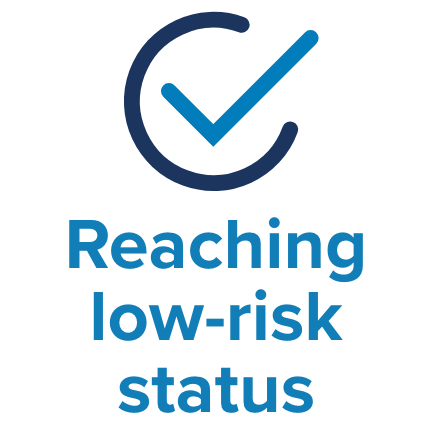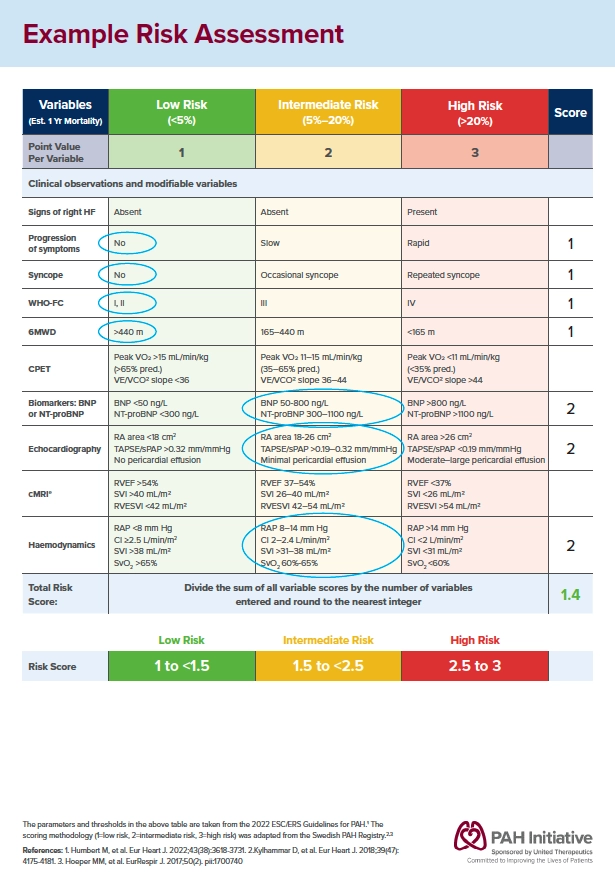How will PAH affect me, and what can I do about it?
You likely had lots of questions about pulmonary arterial hypertension (PAH) after being diagnosed, such as “What is the life expectancy of someone with PAH?”, “How is PAH going to affect me?”, and “What can I do to have the best life possible with PAH?” So how do PAH specialists answer these questions about your unique PAH?
There’s good news: We have better answers to those questions than ever before. Our understanding of PAH and how to manage it have come a long way in recent years. Research has led PAH specialists to adopt an approach to better monitor and treat PAH. It’s called “risk assessment.”
Getting regular risk assessments and lowering your “risk status” could help you live longer, feel better, and do more.
A way to see a fuller picture of your unique PAH
Risk assessment is a way your healthcare provider can better understand your disease. It enables healthcare providers to see a fuller picture of your unique PAH by combining your individual test results into a single “risk status”—high, intermediate, or low risk. Healthcare providers can then use your “risk status” to predict your life expectancy in the coming years and help find the right treatment plan.
Risk assessment is based on research with thousands of PAH patients
Risk assessment is an approach based on research and data from thousands of patients. Like you, these patients were all unique, but when PAH specialists looked at data from all of the patients together, clear patterns emerged. Those patterns identified the most meaningful tests your healthcare provider can perform, and how to combine the results to determine how you’re doing now and predict how you’ll do in the future (your “prognosis”).
Risk assessment is new for many people, including some healthcare providers. A PAH specialist will be experienced in using risk assessment to predict PAH prognosis and guide your care. That’s why it’s important to find a PAH specialist.
How do PAH specialists use risk status to help you?
Hi, I’m Melisa Wilson, nurse practitioner and program coordinator for the Pulmonary Hypertension Program at AdventHealth Orlando. I would like to talk to you today about doing risk assessment with my patients. In the past, when we discuss risk assessment, we used to talk really in terms of how a patient’s feeling, what we call your Functional Class, meaning you tell me if you feel short of breath with certain activities and then I take that and put that into a category. But as humans, we tend to be very smart. If there’s things that make us feel bad, we just don’t do them. So instead, what we have learned over time is that there’s multiple what we call variables or things that we look at, including like your labs and PFT findings and echocardiogram and of course your heart cath information that we can put all together and actually come up with a composite score, which puts you into a category of a high-, low-, or intermediate-risk patient.
This is more prognostic, meaning, telling me how you’re doing not just today but how you’re going to do long term. This number and this grouping is not permanent. It’s not that if you were categorized as high risk that that’s where you are forever. In fact, what that does is gives me, as your clinician, the opportunity to take all of this data that we used to get in pieces or parts. I get your cath data today, I get your lab some other time, I get your 6-minute walk distance, and then have to put that together to kinda say, “Hmm, am I doing enough for you as your provider?” This category or this scoring allows us to put that all together and take a look at everything at once. And then it tells me, if you’re high risk, for example, that I have a lot of opportunity as your clinician to partner with you to make you better. And I can do that through therapies, through rehabs, through diet. All of those things make a difference.
So, when I get you at high risk, my goal ultimately is to move you to low risk. Low risk is where you have the best outcomes. That’s going to happen over time. We’re going to go from high risk to intermediate risk to low risk. And it is our job together to get through that. I’m still going to consider, “How are you doing?” in all of that, but that’s just now going to be one part of the puzzle. So it gives me the opportunity to look at you holistically, as well it gives you the opportunity to have something to work towards in a notable way to notice your improvement in how you’re doing overall with pulmonary arterial hypertension. So it is an exceptionally helpful tool that we didn’t used to have in the past that I’ve become quite passionate about. In fact, with my whole clinic team, we all do this together, 100% involvement, and having these great conversations with all of our patients so that you understand how you’re doing, you can make modifications as well.
I find it changes things like your diet choices. Sometimes people, we make choices that we know aren’t always the best things for us. Maybe it has a lot of sodium. Well, now understanding that that sodium intake could increase what’s called a BNP or an enzyme your heart gives off when it’s under stress or failure, now will make many people, encourage many people, to not eat those high-sodium foods knowing that it can now impact how they’re doing long term. I also find that it helps with things like improvement in 6-minute walk test distance because it helps with the compliance with rehab because you have a goal, something to achieve.
Ultimately, our goal with treating you is to get you from high risk to intermediate risk to low risk, and low risk is where we want to keep you. Low risk we know is associated with better long-term outcomes, meaning that you’re really doing very well from a pulmonary arterial hypertension perspective. So we will partner together to get you through therapies, through rehab, to get you engaged in your healthcare so that we can ultimately get you to that low risk and help you live your best life with PAH. And that’s how I talk to my patients about risk assessment.
What does risk assessment reveal about my life expectancy?
Knowing your risk status could be the key to being able to do more today and to improving your chance of living longer (ie, increased chance of survival). Your risk status is the result of a risk assessment, after your unique test results are combined.
For many patients, the goal is to reach low-risk status because it is associated with better outcomes.
There are 3 main risk status levels: low, intermediate, and high risk.
- your PAH treatment plan is working
- you may be walking further
- you may have fewer symptoms
- you may have a better life expectency over the next 5 years
- your PAH treatment plan may need adjustments
- you may not be able to walk as far
- you may have more symptoms
- you likely have a more moderate life expectancy over the next 5 years
- your PAH treatment plan should be adjusted urgently
- you may not be able to walk without getting breathless
- you may have more severe symptoms
- you will likely have a lower life expectancy over the next 5 years

Most people with PAH fall into the intermediate-risk category. To help them decide how to make better recommendations to update their treatment plan after diagnosis, PAH specialists will split intermediate risk into 2 categories.
- Intermediate-low risk describes individuals at intermediate risk who are closer to low risk
- Intermediate-high risk describes individuals at intermediate risk who are closer to high risk
How is PAH severity (mild, moderate, or severe) different from risk status?
Healthcare providers sometimes use terms like mild, moderate, or severe to describe how PAH affects an individual. These days, you may still hear these terms used informally, but they are not well defined and don’t reflect the best way to understand PAH disease status.
Risk status is similarly a way to describe PAH severity, but the terms low, intermediate, and high risk are more clearly and consistently defined. Because of this, risk status is a much more useful way to understand PAH disease severity. Risk status describes the specific results of a risk assessment looking at your unique combination of test results.
Can risk status change? Yes!
Risk status doesn’t have to stay the same. In fact, it can get better. Your treatment plan, lifestyle, and PAH progression can all impact your risk status. While low-risk status is not achievable for some people, it is a goal that many patients set at the direction of their healthcare provider.
Risk status can also get worse. If your risk status worsens, or if you haven’t improved to low-risk status, your healthcare provider may propose an adjustment to your treatment plan to help you improve your risk status.
Types of PAH Treatments
“I was very high-risk status in the beginning. I got on the right treatment plan and lost weight. My numbers improved and so did my risk status. But I had to do it. Nobody could do it for me.”
—Karen, PAH Initiative Ambassador

What can I do to improve my risk status?
If you’re not at low risk or not making progress in improving your risk status, there may be more that you can do.
Treatment plan adjustments may include:
- Increasing dosage
- Adding medication
- Switching medication
- Making lifestyle changes (for example, diet and exercise changes)
How better test results lead to better life expectancy
Reaching more low-risk criteria can improve your life expectancy. In this video, Dr. Lana Melendres-Groves shows an example of how a risk assessment is completed and details what risks to discuss with your healthcare provider.
So, what is risk assessment?
This concept is at times very difficult to understand, even for me, who's been doing this for quite some time, but it's a different way of looking at PAH. We now know that this risk assessment is so essential to how we treat our patients that it's actually become part of our treatment guidelines. It's recommended that patients receive a risk assessment from their provider on their risk status at least every 3 to 6 months. This measures how well your treatment plan is working for you and it informs your healthcare provider if potentially changes should be made.
What happens during a risk assessment?
During a risk assessment, your healthcare provider will perform many tests and evaluations. These tests and evaluations are the ones that were found in clinical trials to be the most meaningful in determining your current health status and how you’ll likely be doing in the future. These evaluations include the 3 listed below, as well as many others.
Your risk assessment includes:

6-minute walk test
During a risk assessment, your healthcare provider will measure how far you’re able to walk in 6 minutes. This 6-minute walk test gives clues about how your heart, lungs, and blood vessels are doing.

NT-proBNP/BNP
PAH can cause your heart to work harder than normal, which releases high levels of the hormone NT-proBNP/BNP. When this test shows high levels of NT-proBNP/BNP, it means your heart is working harder than normal.

Functional Class
Functional Class is a strong predictor of life expectancy, and it’s an important factor that your healthcare provider uses when choosing your PAH treatments. Functional Class evaluation consists of 4 categories based on the symptoms you experience when doing everyday activities.
The specific tests used in a risk assessment may differ. Learn more about PAH tests.
Download example risk assessment
You can take this sample risk assessment form to your next appointment to help guide your conversation with your healthcare provider about your risk status.
Example Risk Assessment PDFHow often should healthcare providers perform a risk assessment?
Because risk status can change, PAH treatment guidelines state that it’s important for healthcare providers to check PAH risk status when starting a PAH medication and at least once every 3 to 6 months after that. That way, healthcare providers can determine if their current treatment plan is providing the best chance to control PAH.
Not every test may be repeated as part of every risk assessment. Some tests may only be done periodically (not every visit), in which case your healthcare provider may use your most recent test result.
What types of treatments are available for PAH?
PAH treatment includes medications that help to restore balance among natural substances that help keep blood vessels healthy.
Types of PAH Treatments
